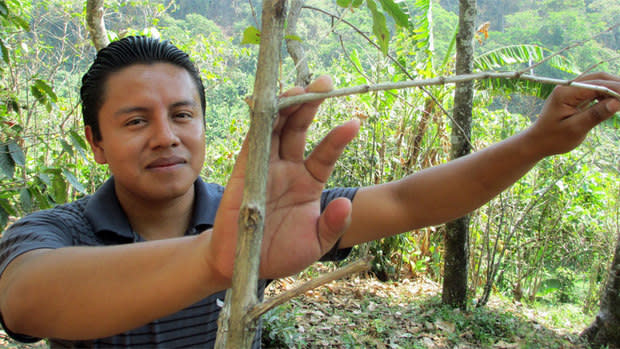Coffee fungus killing crops, jobs from Mexico to Peru

Wilson Tzunún pulls a brown, skinny branch off a coffee plant and snaps it in two. The coffee plants around us are all in varying stages of death.
The cause is something some refer to as "roya." It’s a word that’s almost become a curse in Central America. It’s a fungus, a leaf rust that first shows up as yellow spots on the leaves of coffee plants. Then it curls them up and causes the round coffee fruits to drop to the ground before they can mature.
“It’s something that right now we can’t control,” said Tzunún.
He’s a member of the Campesino Committee of the Highlands in Guatemala. The group helps some of the smallest coffee producers in this country export their organic coffee.
The Guatemalan government has declared the coffee rust a national emergency. So have the governments of Honduras and Costa Rica.
The dried-up, dead plants are an unusual sight, when everything else in this humid region of Western Guatemala is lush and green.
“The roya that attacked before, six to eight years ago, it was controllable,” Tzunún said. “We’ve seen that this is much stronger.”
One of the local farmers is Juan Calel. He grows coffee on three small plots. On one of his plots, every single plant is destroyed.
“It didn’t give us anything,” he said, looking out from under his straw hat. “We don’t know what we’re going to do with this situation, because there’s nothing. Everything was lost.”
Calel is in his 70s and his kids have all left home. Coffee provides his entire income, to support him and his wife. He said it’ll be harder to get by now, but he’s more worried about his neighbours.
“There’s a couple with seven kids, young ones. How are they going to support them all?”
That same concern exists throughout this region.
Nils Leperowski is president of the National Coffee Association in Guatemala. “It’s a problem that goes from Mexico down to Peru.”
He goes through the numbers for Guatemala: 70 per cent of crops have damages. Of the 276,000 hectares of coffee in this country, 193,000 hectares are infected with the fungus.
Related: Coffee beans in danger of extinction
Experts blame climate change.
Leperowski said farmers in coastal regions have seen some leaf rust since the 1980s, but now it’s more resilient and it’s spreading.
“It was the combination of warmer temperatures and humidity. Now we see it at all altitudes in Guatemala.”
He said they have many questions: “This is new. Is this coming to stay or is it cyclical? We don’t know.”
They hope to answer some of these questions, during a summit in Guatemala City that begins April 18. It will include scientists, financial experts, as well as agronomists representing large coffee companies, such as Starbucks.
Leperowski said Guatemala has lost 72,000 direct jobs in the coffee industry this year and he knows there have been many more indirect job losses.
One remedy seems to be using fungicides. In February, the Guatemalan government announced $14 million in aid to help small producers. However, almost two months later, farmers were still waiting to see that aid.
The Campesino Committee of the Highlands is looking to another solution for its few dozen farmers.
Horacio Coz points out what’s growing in their test plot: corn, radishes, cucumbers and cilantro. Farmers will plant these vegetables and herbs along with the young coffee plants they’ll have to put in the ground. Farmers will use some of the crops for their own use; the rest will be sold.
“That’s how we sustain ourselves,” said Coz.
He has a small coffee plot of his own and used to supplement that by working as a casual labourer at a large coffee plantation. It paid him 35 Quetzales ($4.58) a day. But large plantations aren’t immune from these problems and the work dried up, along with the coffee plants.
He’s hopeful the vegetable farming will help out, even though it’ll bring in less money than coffee.
“We’re surviving, little by little.”
Could the spread of the coffee leaf rust have an impact on the coffee we drink here in Canada?
Tim Horton’s is Canada’s biggest buyer of Guatemalan coffee. The company responded in an email that its supply for the next six months has been filled.
Starbucks says it’s monitoring the situation but doesn’t see any challenges meeting its supply. It is concerned about the effects of climate change, though, and recently announced it was expanding a research farm in Costa Rica looking at these issues.
Guatemala’s National Coffee Association says even if the wholesale price of coffee goes up, coffee drinkers likely won’t see a difference.
“Now we’re at $140 US (per 100 pounds). If you put it to $200 and we work it out to cups of coffee, it’s a few cents more,” Leperowski said.
One thing is certain — the problems won’t be solved in one growing season. Coffee plants take three years to mature.

